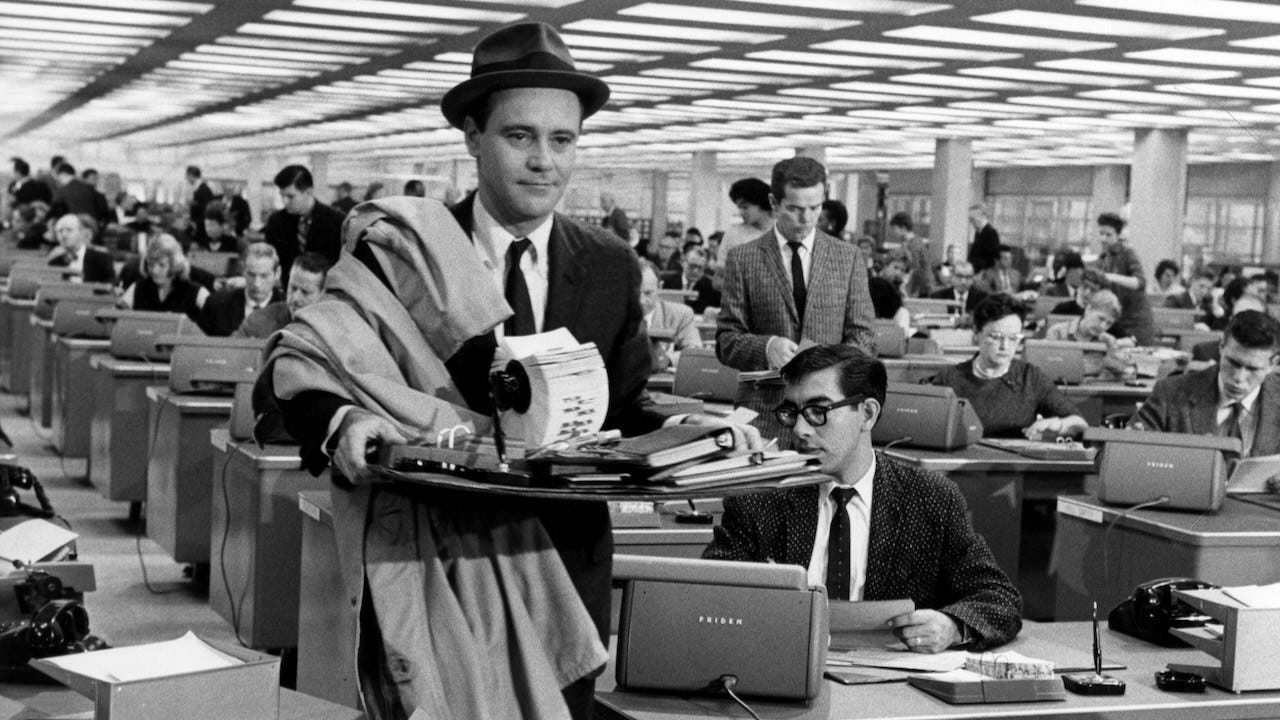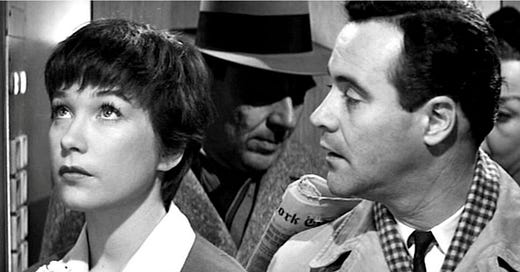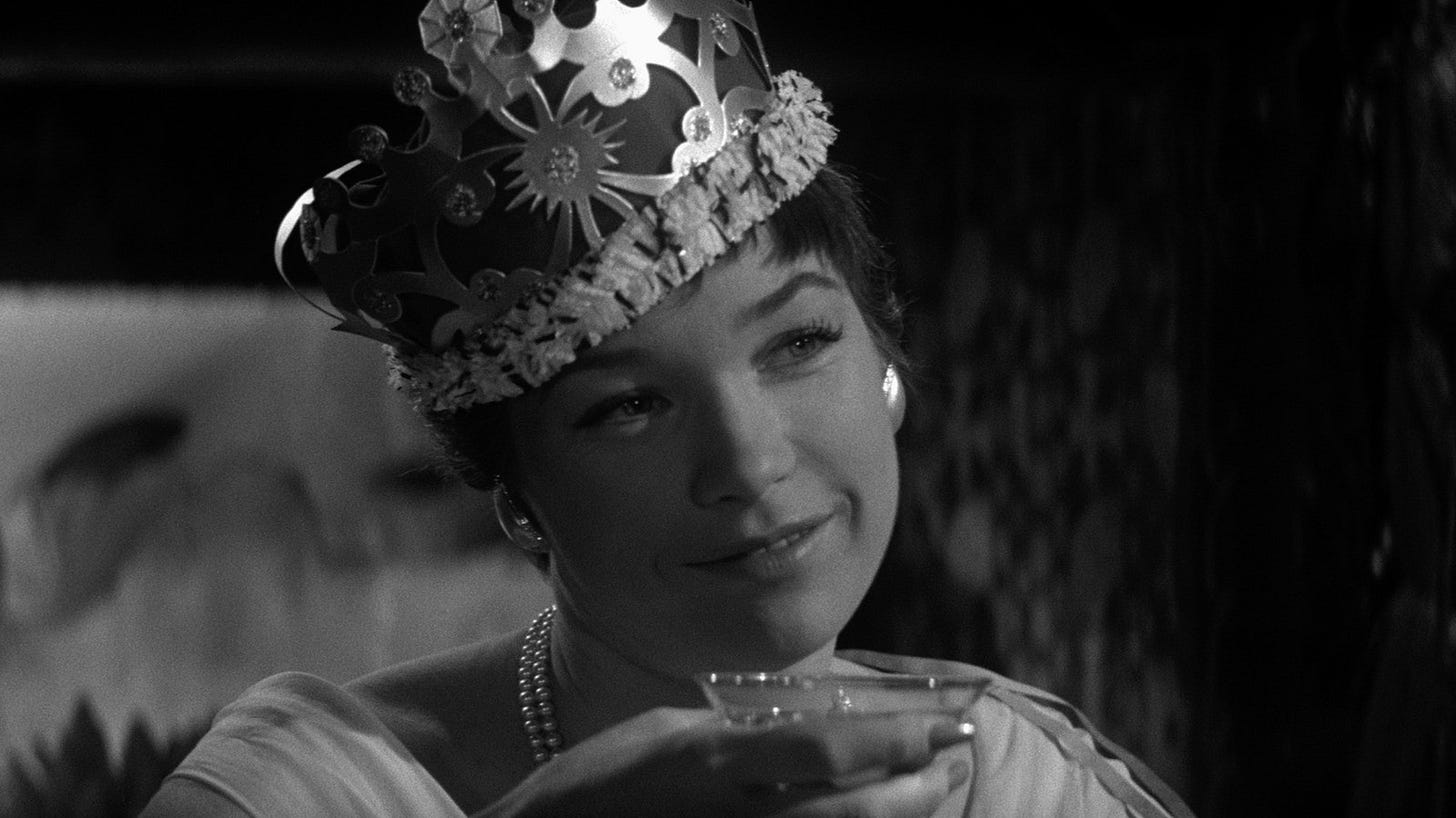‘The Apartment’ and Visual World-building
Billy Wilder’s 1960 classic takes place in just a few sets and yet it sings with visual detail.
NEW STANDARD DISCLAIMER: This newsletter aggressively spoils things.
You can’t watch 2010s horror movies all the time, or so I’m told1, so the other day I sparked up The Apartment, the surprisingly fresh-feeling 1960 classic (it won 5 Oscars!) starring Jack Lemmon and Shirley MacLaine. I’ve seen it before, but ages ago, long before I was a functioning adult capable of actually paying attention to anything for longer than five minutes2. But the Best Picture of 1960 has so many reliably entertaining elements, from Billy Wilder himself to Lemmon and MacLaine, you can never truly go wrong.
It’s always fascinating to watch a film that’s essentially a time capsule. The film was released the same year Season One of Mad Men is set, after all—65 fucking years ago3. The Apartment shows us a glimpse of what life was like back then, which is always fun. I’ve always admired Wilder’s writing—his grasp of the poetry of English slang and vernacular was unparalleled—but watching it a second time I came away with a new appreciation for his visual style. The Apartment is a film that looks great, even in black and white, and conveys so much detail through its visuals. It’s impressive4.
I've Decided to Become a Mensch

The Apartment tells the story of C.C. Baxter (Lemmon), an office drone in an enormous insurance company in New York City. Baxter allows a group of executives to use his apartment on the Upper West Side to conduct their extramarital affairs, with the understanding that they will put in good words and push him for promotion in exchange5. Baxter’s smitten with the cute elevator operator, Fran Kubelik (MacLaine), but discovers that she’s been having an affair with the Director of Personnel, Jeff Sheldrake (Fred MacMurray), when Sheldrake demands to be allowed the use of the apartment as well6.
The opening scene is remarkable for the scale of the company, which supposedly has more than 31,000 employees. Using forced perspective (and children dressed in suits, toward the back), Wilder and production designer Alexandre Trauner created a nearly-infinite office that stretches back so far you get the sense that it’s endless, that this company employs everyone in New York City and possibly beyond7.
It’s an amazing shot, and it underscores Baxter’s meaninglessness8 (thus justifying, to an extent, his amoral approach to success). It also offers something kind of interesting in terms of the gender politics of the film: Women, and a lot of them.
Baxter is a low-level employee, but in the context of the film it’s plausible that he could be promoted to a junior executive level, and thus put on track for upper management. Which means that everyone in that opening shot would technically be capable of a similar career track, including the gals9. But the rest of the film treats women in an achingly more traditional way: They’re either ditzy sex objects, bitter old hags, or steadfast wives. MacLaine’s Ms. Kubilek is kind of a meld of the first and second: She’s the girl all the men want to get with, and she’s slutty enough to sleep with Fred MacMurray, but she’s also wife material.
Junior Executive, Arthur Murray Graduate ... Lover
The Apartment also uses a lot of visual storytelling to convey subtleties. Baxter’s apartment isn’t a weirdly luxurious one; it’s a small one bedroom, crowded with what look like hand-me-down furniture pieces and odd bric-a-brac10. It looks like the sort of place a nobody at an office job would be able to afford (Bud tells us he makes $94.70 per week, which would be about $27,000 a year in 2025 money11, and his rent is $84 a month, which would be a little over $900 today—unheard of on the Upper West Side of Manhattan, of course, even for dingy, run-down apartments). but what’s really remarkable is how Bud moves through it: There’s a balletic grace around Bud, a familiarity. He knows where everything is, he knows exactly how little room he has in the kitchen, he knows exactly how long to leave his TV dinners in the oven12. When he’s forced out of the apartment by one of his selfish “clients” hoping to get laid, we feel Bud’s consternation and unrest as he wanders around Central Park. Wilder does such a good job of making the apartment feel like part of Bud, his natural habitat, that the audience feels his discomfort when he’s ejected.
Released in 1959, the film naturally presents a very, very white America, with a few gestures at immigrants (the Chinese restaurant where Sheldrake woos Ms. Kubelik, Baxter’s Jewish neighbor, Dr. Dreyfuss, who serves as a figure of moral authority for Baxter) and Blacks, represented by a sole shoeblack who buffs up Sheldrake’s shoes in the office in a brief scene. Wilder uses his visual flair for these moments, too. The shoe shine scene stands out because it’s unnecessary to the plot in every way: We spend a few seconds watching Sheldrake getting a shine, he flips the man a half-dollar, and the shoeblack leaves the office13. But it accomplishes a lot. It demonstrates Sheldrake’s position: He’s getting divorced, but he doesn’t care. He’s on top of the world, because he’s looking forward to using Baxter’s apartment later to liaison with Ms. Kubelik, who’s just a bit of fun for him. Sheldrake doesn’t even bother thanking the shoeblack, assuming that his tip (about $6 in today’s money) is all that’s necessary14.
Sure, The Apartment is a relic of a past age in a lot of ways. It’s also a very good story, and crackles with Wilder’s signature harp writing and just as sharp visual sense.
When I worked in an office, there were no dancing-on-the-desks holiday parties. I had to go out at lunch to binge drink like a sucker15.
NEXT WEEK: Wolfs didn’t bother to write characters.
If you enjoy this newsletter, consider subscribing to my paid fiction Substack, Writing Without Rules: From the Notebook!
Then again, people tell me a lot of things, like, you can’t subsist exclusively on whiskey and Slim Jims, or you can’t wear a towel as pants. At this point I don’t know what to believe.
To be fair, the whole “functional adult” thing remains kind of an aspiration.
People really did wear hats all the time. I used to wear a baseball cap every day. All the time. People remarked on it. I have no idea who that person was.
Saying you’re impressed with the work of Billy Wilder is like saying you think being alive is pretty cool. Yes, we know, idiot.
This entire film is about boning and never once makes any explicit reference to boning, which is in itself impressive.
Fred MacMurray played menace so very well it’s a shame most people know him from My Three Sons if they know of him at all. Am I old? Signs point to yes.
During my tenure as an office drone the cubicle walls kept getting lower and lower every time they moved us around. It was terrifying. The idea of being able to see all the other office drones kept me awake at night. When they finally fired me I think I said “Oh, thank god.”
Genius touch: Baxter isn’t even in the front row in the shot. That’s how unimportant he is.
Whenever I’m watching TV with The Duchess and a character that’s a female professional comes on screen I like to turn to her with a shocked expression and say something like “Ladies? Being doctors? What a world!” It does not go over well, but I am committed to the bit.
My roommates and I bought a kitchen table from the previous tenants of our apartment in 1991 for $10 and I hauled that table everywhere I went for the next 20 years. I miss that table.
I made $17,000 at my first job, which would actually be about $38,000 today. That college degree sure paid for itself!
The fact that Budactually heats up TV dinners is a plus. When I was a bachelor many of my dinners were composed of raw materials I hoped combined into something good in my stomach.
All you need to know about my socioeconomic class is this: I have never once gotten a shoe shine, or felt the need for one.
To be fair, the list of things I’ll do for $6 is surprisingly long. Make me an offer.
I did once steal bottles of wine from our holiday party, and felt like a rock star.






